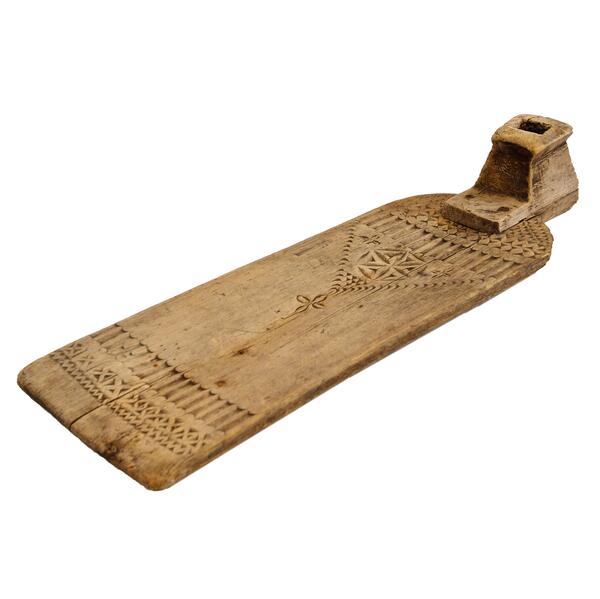The base of this distaff belonged to a family who lived in the village of Krapivka, Lukoyanov district, Nizhny Novgorod province at the end of the 19th century and the first half of the 20th century. It was given to the museum by the archaeologist and ethnographer Vladimir Martyanov. He undertook expedition trips to the Nizhny Novgorod region in 1966-1969, while working on his PhD thesis “ Mordovian carved wood”.
The base of a compound distaff is called “pakar mukoro” in the Mordovian-Erzya language. It is a linden board of rectangular shape with rounded edges and a sawed platform for fixing a leg. The entire surface of the board is covered with a geometric ornament in the technique of chip-carving.
The distaff and the spindle were used to make yarn of wool and plant fiber. The very first distaffs were made from the stembase — the thick part of the trunk above the root. Later there were compound distaffs, consisting of a board for sitting (base) with a hole for fixing the comb with the flax. The bases were decorated with carvings, and with time they turned into real works of arts and crafts.
Making bases formed as an independent craft in the second half of the 18th century, when the demand for hemp, yarn and canvas began to increase. The bases from Nizhny Novgorod differed by the peculiarity of shape and the nature of the ornament. They were wide, shovel-shaped with a semicircular rim on the front and with a carved hole for a comb.
The chip-crving technique has been known to the Mordovian people since the ancient times. Carved ornaments were put on dowry chests, looms, bases of spinning wheels. However, due to the short life of the material, only a small number of decorated objects have survived to this day, the earliest of which dates to the end of the 18th century.
The base of the spinning wheel from Krapivki village is made in such a technique. Placed vertically, it resembles a female figure in a Mordovian shirt. The carved ornament is located in the same way as the embroidery on the clothes, and by its elements repeats the embroidery. In the lower part of the base the master placed three lines of band ornament: broken line, squares, divided diagonally into triangles, and a number of vertical recesses. “The shoulder” of the base is densely filled with zigzags and rhombuses. They are surrounded by a line of ribbon ornament, below which is a solar rosette inscribed in a hexagon. Fine patterns balance the composition and fill the empty space.
The base of a compound distaff is called “pakar mukoro” in the Mordovian-Erzya language. It is a linden board of rectangular shape with rounded edges and a sawed platform for fixing a leg. The entire surface of the board is covered with a geometric ornament in the technique of chip-carving.
The distaff and the spindle were used to make yarn of wool and plant fiber. The very first distaffs were made from the stembase — the thick part of the trunk above the root. Later there were compound distaffs, consisting of a board for sitting (base) with a hole for fixing the comb with the flax. The bases were decorated with carvings, and with time they turned into real works of arts and crafts.
Making bases formed as an independent craft in the second half of the 18th century, when the demand for hemp, yarn and canvas began to increase. The bases from Nizhny Novgorod differed by the peculiarity of shape and the nature of the ornament. They were wide, shovel-shaped with a semicircular rim on the front and with a carved hole for a comb.
The chip-crving technique has been known to the Mordovian people since the ancient times. Carved ornaments were put on dowry chests, looms, bases of spinning wheels. However, due to the short life of the material, only a small number of decorated objects have survived to this day, the earliest of which dates to the end of the 18th century.
The base of the spinning wheel from Krapivki village is made in such a technique. Placed vertically, it resembles a female figure in a Mordovian shirt. The carved ornament is located in the same way as the embroidery on the clothes, and by its elements repeats the embroidery. In the lower part of the base the master placed three lines of band ornament: broken line, squares, divided diagonally into triangles, and a number of vertical recesses. “The shoulder” of the base is densely filled with zigzags and rhombuses. They are surrounded by a line of ribbon ornament, below which is a solar rosette inscribed in a hexagon. Fine patterns balance the composition and fill the empty space.



